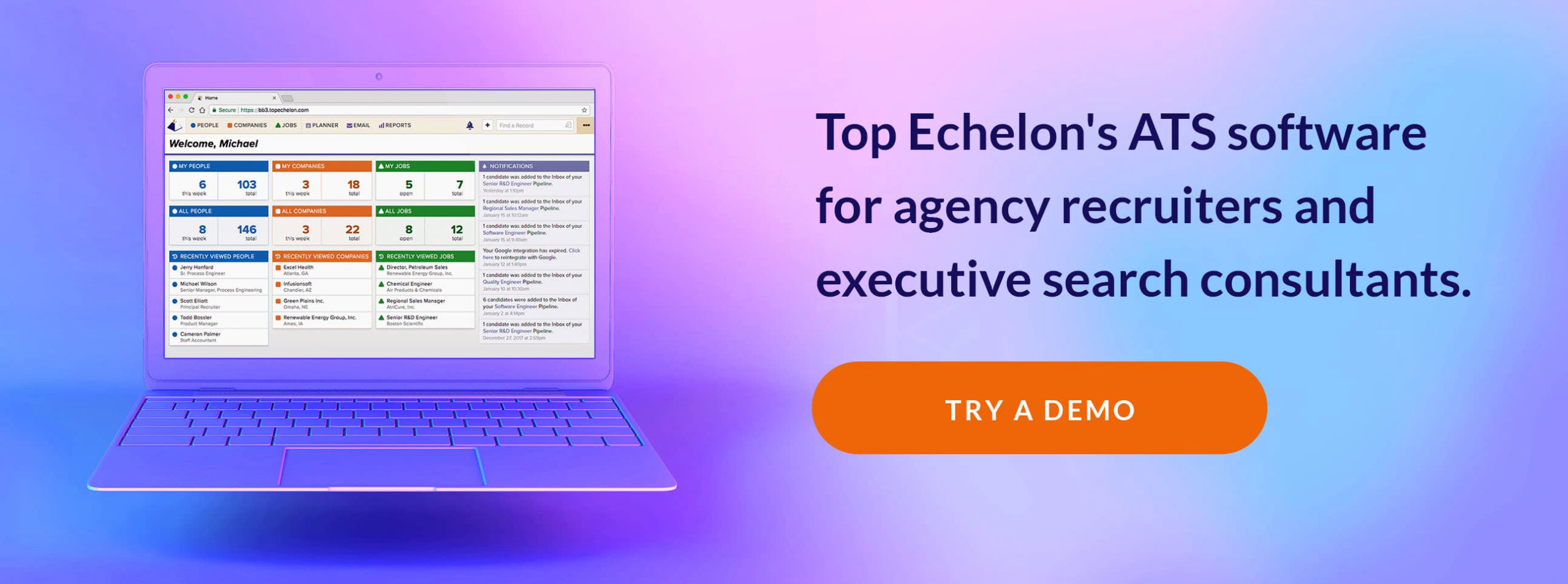Simple and effective internal office communication is integral to the success of any recruitment team. When you only employ a couple of people, communication is easy. But as soon as your small group of recruiters grows into a team, communication becomes more complicated. As you grow, It’s easy to lose focus and fall into the trap of poor communication, and poor communication leads to a drop in productivity, which you cannot afford. To scale your office communication methods, you’ll have to address your recruiting team structure, start holding short, intentional meetings, develop best practices, and implement helpful communication tools to streamline your work. In doing so, you’ll be able to hire more employees without sacrificing productivity and improve communication within a recruiting team.
Recruiting Team Structure
Building a team structure within your company is the first step to seamless internal communication, because it creates a chain of command for your employees to follow. Knowing who reports to whom is half of the battle, and it eliminates any confusion as to whom lower level employees take their cues from. Recruiting team structure depends entirely on your company’s processes, but generally, a medium-sized recruiting agency is going to have four distinct hierarchical levels.
- Agency Director: The agency director is the primary decision-maker of the company, so they aren’t as concerned with the common day-to-day tasks, and instead focus on big-picture decisions, like finances and company direction. Sales and recruiting managers report to the agency director, but junior employees will have no need.
- Sales Manager: The sales manager oversees business development. They will generally have a small team of sales and customer success representatives. They report to the agency director and manage their junior employees.
- Recruiting Manager: The recruiting manager oversees all candidate-facing activities. Junior sourcers and recruiters report to the recruiting manager, who, in turn, reports to the agency director.
- Recruiters/Sourcers/Sales/Support Staff: These positions generally have no one reporting to them and they report to their respective managers.
Effective Team Meetings
As your company grows, it’s vital that you make short, effective team meetings a part of your internal communication strategy. Meetings sometimes have a reputation for hurting productivity or being unnecessary, but you can avoid those pitfalls by developing structured meetings. Structure in meetings means scheduling meetings for a specific, small-scope purpose, with only the necessary parties. Structured meetings should only last as long as they are scheduled — if it’s supposed to be a 15-minute meeting, don’t go over time; find a way to reach a conclusion and decide if a follow-up meeting needs to happen. Don’t be afraid to end a meeting early if there’s nothing left to discuss, either. Here are a few types of effective team meetings you can work into your process.
- One-on-Ones: These meetings just act as check-in meetings between you and your employees. One-on-one meetings should be held a couple times every year. Let them be a safe place for your employees to voice their triumphs and concerns. Learn what you can about them to show you care.
- Departmental: Have your managers hold meetings with their department regularly. For some companies, each department holds a short kanban meeting every morning to discuss what we worked on the previous day and what we’re planning on getting done that day. We keep these daily meetings very short (<10 minutes), and it keeps us in sync and on the right track.
- Company: At some companies, there are company-wide meetings once a week once or a couple times a week. It serves as a way for each department to share what they’ve been working on and for different departments to get on the same page. It’s also a place where employees can voice their opinions and concerns and bounce ideas off one another. It also provides a nice opportunity to bond with co-workers.
Beyond scheduling meetings, you should also go into them with a plan. Come with an outline of what you want to cover and what decisions need to be made, assign someone in the meeting to take notes and assign someone to lead and keep everyone focused. Follow these best practices so you can keep your meetings on track.
Develop Best Practices
Developing best practices is another way to keep internal communication tight in an expanding company. As you move forward and figure out the way your company runs most efficiently, start to formalize processes and best practices by writing them down. Documenting processes is important because it establishes a mutually agreed-upon version of the truth for all employees — a codified “right” or “best” way to do things. This is helpful for managers who are course correcting; they can point their employees to the document as a reference point for how they want the work done. Also, developing best practices makes the onboarding process much easier as you bring on new recruiters. Of course, these processes can (and should!) grow and change — what worked for 5 employees might not work for 25. Continual reassessment of processes is vital; just make sure you document it.
Use Your ATS for Communication
Effectively using your ATS (applicant tracking system) can improve internal communication in your recruiting business. The best recruitment software contains features that track all activities related to a record, making it easy for any employee to see the entire history of your company’s interaction with candidates, clients, and job orders.
- Notes and Activities: Leaving notes on a record enables your employees to document their work as they go. A great ATS will let them tie that note to a specific activity, like “Call” or “Left Voicemail.” Be sure that your employees enter notes and activities in a unified way, so as to avoid any confusion.
- Email sync: Email synchronization pulls in any email correspondence between a recruiter and a candidate or client and attaches those emails to the appropriate record. This makes it so that other recruiters can go through and see exactly what has been discussed and can move forward on those records appropriately if needed, without risk of sending the same information twice, or asking a question that a candidate/client has already answered.
- Status Tracking: Your ATS should have some sort of workflow functionality that features candidate statuses corresponding to different points along your recruitment process. That way, as you move candidates to the next stage in the pipeline, your system makes a note of it for future reference. An ATS that tracks these statuses provides you with the exact path a record took once they were in your database. Status tracking is vital to have if you wish to see how your business is being run and effectively adjust.
- Reports: If your ATS tracks all of this data, you should be able to export and read it in some way. An ATS that presents data in an easy-to-read way is invaluable to the growing recruiting firm, because being able to understand and then act on your data is paramount to growth.
Best Internal Communication Tools
Familiarize yourself with tools built specifically for making office communication easier. Clean, modern, and already widely used, you cannot go wrong with any of these options. However, you can browse a longer, review list of communication tools here.
- Slack: One of the most popular team communication tools on the market. Slack’s chat is well designed, easy to use, and most recruiting software (and most software in general) has an integration with it.
- Google Docs: Google Docs is a team collaboration tool. You can create documents or spreadsheets, share them among your company, comment and suggest within those documents, and organize them into folders with custom access. Google Docs is entirely cloud based, so you can access necessary documents as long as you have internet access.
- Igloo: Igloo is an intranet that acts as an informational center for your company, and it can even be customized to show industry news, tasks, and more. Think of Igloo as the internal wiki for your recruiting company.
- Big Biller: Big Biller is an applicant tracking system that features many different ways to help facilitate interaction between you and your candidates.
Being a part of an expanding recruiting company is exciting, but if you don’t scale your communication processes with how quickly you grow, you’re going to stumble and lose productivity. Tools such as your ATS and other pieces of software can help facilitate communication, so take advantage of them when you can. Start by developing a hierarchy as you add more roles to your team. Schedule structured meetings and document best practices so employees can all stay on the same page and be of one mind, and you will ensure that your company moves forward and upward as a cohesive unit for years to come.









